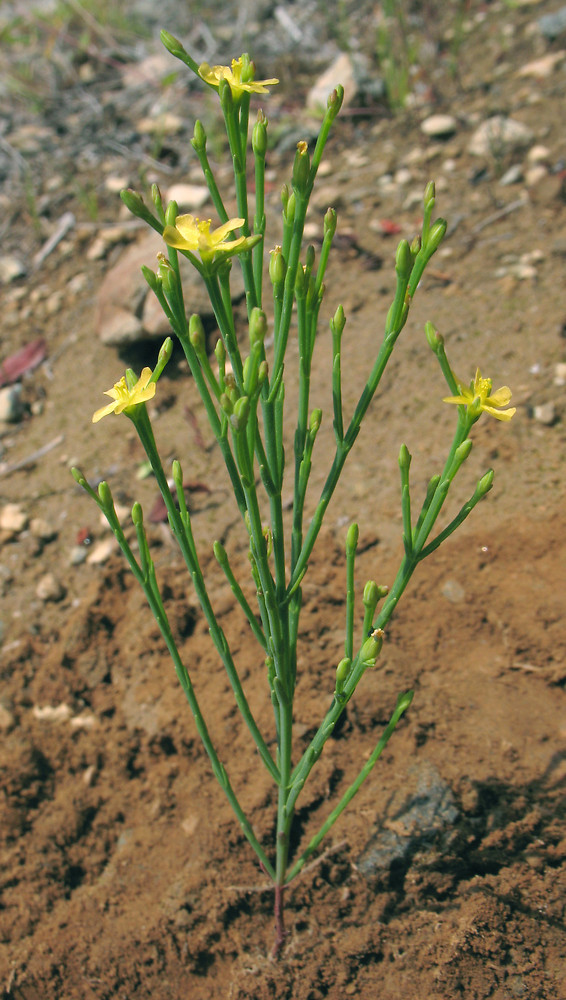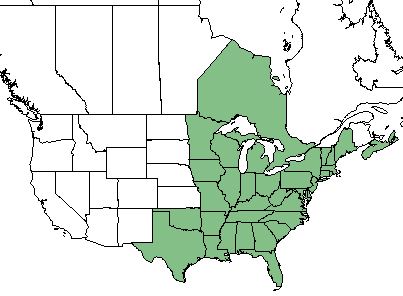Hypericum gentianoides
Common name: orangegrass [1], pineweed [2]
| Hypericum gentianoides | |
|---|---|

| |
| Photo by Marilee Lovit at the GoBotany Database | |
| Scientific classification | |
| Kingdom: | Plantae |
| Division: | Magnoliophyta - Flowering plants |
| Class: | Magnoliopsida - Dicots |
| Order: | Theales |
| Family: | Clusiaceae |
| Genus: | Hypericum gentianoides |
| Species: | H. gentianoides |
| Binomial name | |
| Hypericum gentianoides L | |

| |
| Natural range of Hypericum gentianoides from USDA NRCS Plants Database. | |
Contents
Taxonomic Notes
Synonyms: Sarothra gentianoides Linnaeus
Varieties: none
Description
H. gentianoides is an annual forb/herb of the Clusiaceae family native to North America and Canada.[1] It has scaly leaves that are arranged on erect and wiry branches. Flowers are tiny and yellow, and only open with sunlight. Fruit capsules are usually red in color.[3]
Distribution
H. gentianoides is found in the eastern half of the United States, as well as the Ontario region of Canada.[1] More specifically, it is distributed from Maine and Ontario west to Minnesota, and south to southern Florida and Texas.[2]
Ecology
Habitat
H. gentianoides proliferates in fields, rock outcrops, woodland borders, eroding areas, pond margins, and flatwoods.[2] It mostly grows in areas that are open with sandy or rocky soils; it can also tolerate partial shade.[3] Specimens have been collected from loamy loose sand, wet pine flatwoods, longleaf pine depression, and sandhills. [4] H. gentianoides responds negatively towards soil disturbance in historically forest longleaf pine communities in South Carolina.[5] However, it has been shown to significantly increase in frequency when the overstory is clearcut.[6] It also has been shown to respond positively to pine thinning as well as woody control.[7] It is listed by the USDA Natural Resources Conservation Service as a facultative upland species, where it most often occurs in non-wetland habitats but can also occasionally be found in wetland habitats as well.[1]
Associated species includes Selaginella arenicola, Polygonella sp., and Stipulicida setacea.[4]
Phenology
Generally, H. gentianoides flowers from July until October.[2] It has been observed flowering in May through July and September. [8]
Seed dispersal
This species is thought to be dispersed by gravity. [9]
Seed bank and germination
It was found to be a member of the seed bank at a loblolly pine restoration site in southwest Georgia even when it was not a component of the herbaceous vegetation.[10]
Fire ecology
H. gentianoides is very often found growing in firelanes.[11]
Use by animals
It consists of approximately 2-5% of the diet for various large mammals and terrestrial birds.[12]
Conservation and Management
H. gentianoides is listed as endangered by the Iowa Department of Natural Resources Parks, Recreation, and Preserves Division.[1] It is also considered vulnerable in Michigan, imperiled in Vermont, critically imperiled in Oklahoma and Ontario, and an exotic species in the Canadian provinces of New Brunswick, Nova Scotia, and Prince Edward Island.[13]
Cultivation and restoration
Photo Gallery
References and notes
- ↑ 1.0 1.1 1.2 1.3 1.4 USDA Plant Database https://plants.usda.gov/core/profile?symbol=HYGE
- ↑ 2.0 2.1 2.2 2.3 Weakley, A. S. (2015). Flora of the Southern and Mid-Atlantic States. Chapel Hill, NC, University of North Carolina Herbarium.
- ↑ 3.0 3.1 [[1]] Lady Bird Johnson Wildflower Center. Accessed: May 23, 2019
- ↑ 4.0 4.1 URL: http://herbarium.bio.fsu.edu. Last accessed: June 2018. Collectors: Loran C. Anderson, Leon Neel, Andre Clewell, R.F. Doren, R.K. Godfrey, Cecil Slaughter, Wilson Baker, Ann Johnson, John Nelson, Keith Bradley. States and counties: South Carolina (Dillon) Florida (Bay, Flagler, Duval, Leon, Wakulla, Franklin) Georgia (Baker, Thomas)
- ↑ Brudvig, L.A. and E.I. Damchen. (2011). Land-use history, historical connectivity, and land management interact to determine longleaf pine woodland understory richness and composition. Ecography 34: 257-266.
- ↑ Brockway, D. G. and C. E. Lewis (2003). "Influence of deer, cattle grazing and timber harvest on plant species diversity in a longleaf pine bluestem ecosystem." Forest Ecology and Management 175: 49-69.
- ↑ Harrington, T. B. (2011). "Overstory and understory relationships in longleaf pine plantations 14 years after thinning and woody control." Canadian Journal of Forest Research 41: 2301-2314.
- ↑ Nelson, G. PanFlora: Plant data for the eastern United States with emphasis on the Southeastern Coastal Plains, Florida, and the Florida Panhandle. www.gilnelson.com/PanFlora/ Accessed: 22 MAY 2018
- ↑ Kirkman, L. Katherine. Unpublished database of seed dispersal mode of plants found in Coastal Plain longleaf pine-grasslands of the Jones Ecological Research Center, Georgia.
- ↑ Andreu, M. G., et al. (2009). "Can managers bank on seed banks when restoring Pinus taeda L. plantations in Southwest Georgia?" Restoration Ecology 17: 586-596.
- ↑ Clarke, G. L. and W. A. Patterson (2007). "The distribution of disturbance-dependent rare plants in a coastal Massachusetts sandplain: implications for conservation and management." Biological Conservation 136: 4-16.
- ↑ Miller, J.H., and K.V. Miller. 1999. Forest plants of the southeast and their wildlife uses. Southern Weed Science Society.
- ↑ [[2]] NatureServe Explorer. Accessed: May 23, 2019